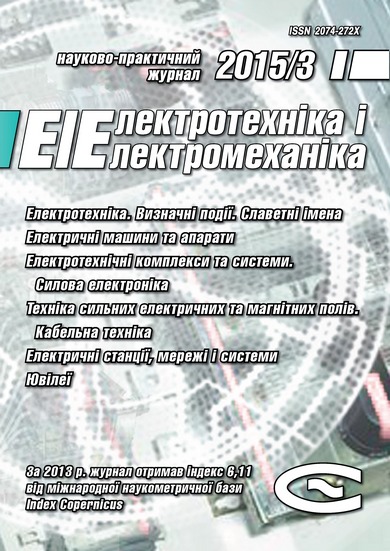A COMPUTERIZED DIAGNOSTIC COMPLEX FOR RELIABILITY TESTING OF ELECTRIC MACHINES
DOI:
https://doi.org/10.20998/2074-272X.2015.3.04Keywords:
electric machine, reliability, temperature, vibration parametersAbstract
Purpose. To develop a diagnostic complex meeting the criteria and requirements for carrying out accelerated reliability test and realizing the basic modes of electric machines operation and performance of the posed problems necessary in the process of such test. Methodology. To determine and forecast the indices of electric machines reliability in accordance with the statistic data of repair plants we have conditionally divided them into structural parts that are most likely to fail. We have preliminarily assessed the state of each of these parts, which includes revelation of faults and deviations of technical and geometric parameters. We have determined the analyzed electric machine controlled parameters used for assessment of quantitative characteristics of reliability of these parts and electric machines on the whole. Results. As a result of the research, we have substantiated the structure of a computerized complex for electric machines reliability test. It allows us to change thermal and vibration actions without violation of the physics of the processes of aging and wearing of the basic structural parts and elements material. The above mentioned makes it possible to considerably reduce time spent on carrying out electric machines reliability tests and improve trustworthiness of the data obtained as a result of their performance. Originality. A special feature of determination of the controlled parameters consists in removal of vibration components in the idle mode and after disconnection of the analyzed electric machine from the power supply with the aim of singling out the vibration electromagnetic component, fixing the degree of sparking and bend of the shaft by means of phototechnique and local determination of structural parts temperature provided by corresponding location of thermal sensors. Practical value. We have offered a scheme of location of thermal and vibration sensors, which allows improvement of parameters measuring accuracy due to determination of the spatial vector of vibration and local temperatures of structural parts.References
Zakladnyi O.M., Zakladnyi O.O. Universal diagnostic complex for electric motors rapid test. Informatsiinyi zbirnyk «Promyslova elektroenerhetyka ta elektrotekhnika» Promelektro – Informational collected papers «Promyslova electroenergetyka ta elektrotekhnyka» Promelektro, 2007, no.4, pp. 35-39. (Ukr).
Prus V.V., Kolotylo І.А., Ugarov А.V. Computer-aided complex for post-repair test of induction motors with change of properties of stator cores. Visnyk Kremenchutskoho derzhavnoho politekhnichnoho universytetu – Transactions of Kremenchuk State Polytechnic University, 2005, no.3(32), pp. 184-186. (Ukr).
Barkov А.V., Barkova N.А., Borisov А.А. Vibracionnaja diagnostika jelektricheskih mashin v ustanovivshihsja rezhimah raboty: metodicheskie ukazanija [Vibration diagnostics of electric machines in steady states of operation: manual]. St. Petersburg, North-West training center Publ., 2006. 36 p. (Rus).
Prus V.V., Zagirnyak М.V., Kolotylo І.А. Determination of the maximum temperature of stator winding of repaired induction motors. Visnyk Kremenchutskoho derzhavnoho politekhnichnoho universytetu – Transactions of Kremenchuk State Polytechnic University, 2008, no.3(50), part 2, pp. 68-72. (Rus).
Somka О.О., Prus V.V. Sposib vyznachennia ta prohnozuvannia pokaznykiv nadiinosti elektrychnykh mashyn [Method of determination and forecasting of the indices of electric machines reliability]. Patent UA, no.88527, 2014. (Ukr).
Somka O.O. Development of reliability model taking into account the change of the state of electric machine structural units. Zbirnyk naukovykh prats X Mizhn. nauk.-tekhn. konf. molodykh uchenykh i spetsialistiv [Conf. proceedings of the 10th Int. conf. of students and young researches]. Kremenchuk, 2012, pp. 358-359. (Rus).
Downloads
Published
How to Cite
Issue
Section
License
Copyright (c) 2015 O. O Somka, V. V. Prus

This work is licensed under a Creative Commons Attribution-NonCommercial 4.0 International License.
Authors who publish with this journal agree to the following terms:
1. Authors retain copyright and grant the journal right of first publication with the work simultaneously licensed under a Creative Commons Attribution License that allows others to share the work with an acknowledgement of the work's authorship and initial publication in this journal.
2. Authors are able to enter into separate, additional contractual arrangements for the non-exclusive distribution of the journal's published version of the work (e.g., post it to an institutional repository or publish it in a book), with an acknowledgement of its initial publication in this journal.
3. Authors are permitted and encouraged to post their work online (e.g., in institutional repositories or on their website) prior to and during the submission process, as it can lead to productive exchanges, as well as earlier and greater citation of published work.





